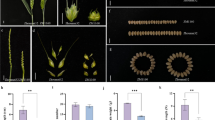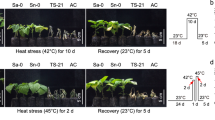Abstract
One way to transfer apomixis (asexual reproduction through seeds) to major crops could be through genetic transformation, but for this a set of transgenes that triggers each of the involved processes should be generated. Although most angiosperms require an endospermic balance number (EBN) for normal endosperm development, tetraploid Paspalum notatum is EBN- insensitive. Here, a candidate gene (GG13) of Paspalum notatum associated with endosperm development in insensitive EBN crosses was analyzed by gene silencing in Arabidopsis thaliana. When comparing the silenced and control conditions, silenced condition evidenced less relative expression in RT-qPCR experiments, more abortions (6 vs. 1), fewer seeds (16 vs. 34), a more elongated shape (shape index 1.83 vs. 1.57), and lower germination (4 vs. 36 %) in phenotypic analyses. The above results were consistent with bioinformatically predicted functions for GG13 gene. Therefore, the importance of the GG13 gene in endosperm development in EBN-insensitive seeds was demonstrated, offering the possibility of incorporating apomixis into major crops.




Similar content being viewed by others
References
Binder A, Lambert J, Morbitzer R, Popp C, Ott T, Lahaye T, Parniske M (2014) A Modular Plasmid Assembly Kit for Multigene Expression, Gene Silencing and Silencing Rescue in Plants. PLoS ONE 9(2):e88218. https://doi.org/10.1371/journal.pone.0088218
Boavida LC, Shuai B, Yu H, Pagnussat GC, Sundaresan V, McCormick S (2009) A Collection of Ds Insertional Mutants Associated with Defects in Male Gametophyte Development and Function in Arabidopsis thaliana. Genetics 181:1369–1385
Boettcher M, McManus MT (2015) Choosing the Right Tool for the Job: RNAi, TALEN, or CRISPR. Mol Cell 58(4):575–585
Bologna NG, Voinnet O (2014) The diversity, Biogenesis, and Activities of Endogenous Silencing Small RNAs in Arabidopsis. Annu Rev Plant Biol 65(28):1–31
Burton GW (1948) The method of reproduction in common Bahiagrass, Paspalum notatum. Journal of American Society of Agronomy 40:443–452
Clough SJ, Bent AF (1998) Floral dip: a simplified method for Agrobacterium-mediated transformation of Arabidopsis thaliana. Plant J 16(6):735–743
Czechowski T, Stitt M, Altmann T, Udvardi MK, Scheible W (2005) Genome-Wide Identification and Testing of Superior Reference Genes for Transcript Normalization in Arabidopsis. Plant Physiol 139(1):5–17
Di Rienzo JA, Casanoves F, Balzarini MG, Gonzalez L, Tablada M, Robledo CW (2016) InfoStat. Grupo InfoStat. FCA, Universidad Nacional de Córdoba, Argentina
Felitti SA, Acuña CA, Ortiz JPA, Quarin CL (2015) Transcriptome analysis of seed development in apomictic Paspalum notatum. Ann Appl Biol. doi:https://doi.org/10.1111/aab.12206
Hajduch M, Hearne LB, Miernyk JA, Casteel JE, Joshi T, Agrawal GK, Song Z, Zhou M, Xu D, Thelen JJ (2010) Systems Analysis of Seed Filling in Arabidopsis: Using General Linear Modeling to Assess Concordance of Transcript and Protein Expression. Plant Physiol 152:2078–2087
Helliwell C, Waterhouse P (2003) Constructs and methods for high-throughput gene silencing in plants. Methods 30:289–295
Houston NL, Fan C, Xiang Q, Schulze JM, Jung R, Boston RS (2005) Phylogenetic Analyses Identify 10 Classes of the Protein Disulfide Isomerase Family in Plants, Including Single-Domain Protein Disulfide Isomerase-Related Proteins. Plant Physiol 137:762–778
Kaushal P, Roy AK, Khare A, Malaviya DR, Zadoo SN, Choubey RN (2007) Crossability and Characterization of Interspecific Hybrids between Sexual Pennisetum glaucum (Pearl Millet) and a New Cytotype (2n56) of Apomictic P. squamulatum. Cytologia 72(1):111–118
Kaushal P, Khare A, Siddiqui SA, Agrawal A, Sharmishtha P, Malaviya DR, Roy AK, Zadoo SN (2010) Morphological, cytological and reproductive characterization of tri-species hybrids (GOS) between Pennisetum glaucum, P. orientale and P. squamulatum. Euphytica 174:261–228
Kaushal P, Dwivedi KK, Radhakrishna A, Srivastava MK, Kumar V, Roy AK, Malaviya DR (2019) Partitioning Apomixis Components to Understand and Utilize Gametophytic Apomixis. Front Plant Sci 10:256. doi:https://doi.org/10.3389/fpls.2019.00256
Kimura S, Higashino Y, Kitao Y, Masuda T, Urade R (2015) Expression and characterization of protein disulfide isomerase family proteins in bread wheat. BMC Plant Biol 15:73. DOI https://doi.org/10.1186/s12870-015-0460-2
Krysan PJ, Young JC, Sussman MR (1999) T-DNA as an Insertional Mutagen in Arabidopsis. Plant Cell 11:2283–2290
Lersten NR, Curtis JD (1988) Secretory reservoirs (ducts) of two kinds in giant ragweed (Ambrosia trifida; Asteraceae). Am J Bot 75(1):1313–1323
Li CP, Larkins BA (1996) Expression of protein disulfide isomerase is elevated in the endosperm of the maize floury-2 mutant. Plant Mol Biol 30:873–882
Livak K, Schmittgen TD (2001) Analysis of Relative Gene Expression Data Using Real-Time Quantitative PCR and the 2-∆∆C T Method. Methods 25:402–408
Mancini M, Permingeat H, Colono C, Siena L, Pupilli F, Azzaro C, Dusi D, Carneiro V, Podio M, Seijo G, Gonzalez A, Felitti SA, Ortiz JPA, Leblanc O, Pessino SC (2018) The MAP3K-coding QUI-GON JINN (QGJ) gene is essential to the formation of unreduced embryo sacs in paspalum. Front Plant Sci. https://doi.org/10.3389/fpls.2018.01547
Martínez EJ, Urbani MH, Quarín CL, Ortiz JPA (2001) Inheritance of apospory in bahiagrass, Paspalum notatum. Hereditas 135:9–25
Martínez EJ, Hopp HE, Stein J, Ortiz JPA, Quarin CL (2003) Genetic characterization of apospory in tetraploid Paspalum notatum based on the identification of linked molecular markers. Mol Breed 12:319–327
Nogler GA (1984) Gametophytic apomixis. In: Johri BM (ed) Embryology of angiosperms. Springer, Berlín, pp 475–518
Onda Y (2013) Oxidative Protein-Folding Systems in Plant Cells. Int J Cell Biol. https://doi.org/10.1155/2013/585431
Onda Y, Kobori Y (2014) Differential activity of rice protein disulfide isomerase family members for disulfide bond formation and reduction. FEBS Open Bio 4:730–734
Ortiz JPA, Quarin CL, Pessino SC, Acuña CA, Martínez EJ, Espinoza F, Hojsgaard DH, Sartor ME, Cáceres M-E, Pupilli F (2013) Harnessing apomictic reproduction in grasses: what we have learned from Paspalum. Ann Bot 112(5):767–768
Pfaffl MW (2001) A new mathematical model for relative quantification in real-time RT-PCR. Nucleic Acids Res 29(9):2003–2007
Pozzi FI, Pratta GR, Acuña CA, Felitti SA (2018) Xenia in bahiagrass: gene expression at initial seed formation. Seed Sci Res. doi https://doi.org/10.1017/S0960258518000375
Pupilli F, Barcaccia G (2012) Cloning plants by seeds: inheritance models and candidate genes to increase fundamental knowledge for engineering apomixis in sexual crops. Journal of Biotech 159:291–311
Quarin CL (1999) Effect of pollen source and pollen ploidy on endosperm formation and seed set in pseudogamous apomictic Paspalum notatum. Sex Plant Reprod 11:331–335
Roustan V, Roustan PJ, Weidinger M, Reipert S, Kapusi E, Shabrangy A, Stoger E, Weckwerth W, Ibl V (2018) Microscopic and Proteomic Analysis of Dissected Developing Barley Endosperm Layers Reveals the Starchy Endosperm as Prominent Storage Tissue for ER-Derived Hordeins Alongside the Accumulation of Barley Protein Disulfide Isomerase (HvPDIL1-1). . Front Plant Sci 9:1248
Savidan Y (2000) Apomixis: Genetics and Breeding. In: Janick J (ed) Plant Breeding Reviews. John Wiley & Sons, Inc, London, pp 13–86
Sahu PP, Gupta S, Malaviya DR, Roy AK, Kaushal P, Prasad M (2012) Transcriptome Analysis of Differentially Expressed Genes During Embryo Sac Development in Apomeiotic Non-Parthenogenetic Interspecific Hybrid of Pennisetum glaucum. Mol Biotechnol 51:262–271
Sijen T, Vijn I, Rebocho A, Van Blokland R, Roelofs D, Mol J, Kooter JM (2001) Transcriptional and posttranscriptional gene silencing are mechanistically related. Curr Biol 11(6):436–440
Simon P (2003) Q-Gene: processing quantitative real-time RT–PCR data. Bioinformatics 19:1439–1440
Souza AJ, Januzzi Mendes BM, Alves Mourão Filho FA (2007) Gene Silencing: Concepts, Applications and perspectives in woody plants. Rev Sci Agric 64(6):645–656
Tiwari M, Sharma D, Trivedi PK (2014) Artificial microRNA mediated gene silencing in plants: progress and perspectives. Plant Mol Biol 86:1–18
Vázquez Rovere C, Bazzini A, Rodríguez C, Almasia N, Asurmendi S (2010) Usos del silenciamiento génico para el análisis funcional de genes candidatos. In: Levitus G, Echenique V, Rubinstein C, Hopp E, Mroginski L (eds) Biotecnología y Mejoramiento Vegetal II. INTA, Buenos Aires, pp 259–270
Wang K (2006) Agrobacterium protocols. Humana Press, Totowa
Wang H, Boavida LC, Ron M, McCormick S (2008) Truncation of a Protein Disulfide Isomerase, PDIL2-1, Delays Embryo Sac Maturation and Disrupts Pollen Tube Guidance in Arabidopsis thaliana. Plant Cell 20:3300–3311
Acknowledgements
We thank Ph.D. John W. Miles for his valuable advice and discussions. This work was financed by the Consejo Nacional de Investigaciones Científicas y Técnicas (CONICET) grant PIP-11220090100613 and P-UE: 22920160100043CO (IICAR), the Agencia Nacional de Promoción Científica y Tecnológica (ANPCyT) grant PICT-2012-1321, the Secretaría de Ciencia y Técnica, Universidad Nacional de Rosario (UNR) grants AGR233 y AGR317. CA Acuña and SA Felitti are research career members of the Consejo Nacional de Investigaciones Científicas y Técnicas (CONICET). CL Quarin is a professor in the Facultad de Ciencias Agrarias, Universidad Nacional del Nordeste. The authors declare that they have no conflict of interest.
Funding
This work was financed by the Consejo Nacional de Investigaciones Científicas y Técnicas (CONICET) grant PIP-11,220,090,100,613 and P-UE: 22920160100043CO (IICAR), the Agencia Nacional de Promoción Científica y Tecnológica (ANPCyT) grant PICT-2012-1321, the Secretaría de Ciencia y Técnica, Universidad Nacional de Rosario (UNR) grants AGR233 y AGR317.
Author information
Authors and Affiliations
Corresponding author
Ethics declarations
Conflict of interest
The author declares their is no conflict of interest.
Additional information
Publisher’s Note
Springer Nature remains neutral with regard to jurisdictional claims in published maps and institutional affiliations.
Rights and permissions
About this article
Cite this article
Pozzi, F.I., Acuña, C.A., Quarin, C.L. et al. GG13: a candidate gene related to seed development and viability from apomictic Paspalum notatum. Euphytica 217, 148 (2021). https://doi.org/10.1007/s10681-021-02881-1
Received:
Accepted:
Published:
DOI: https://doi.org/10.1007/s10681-021-02881-1




